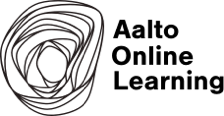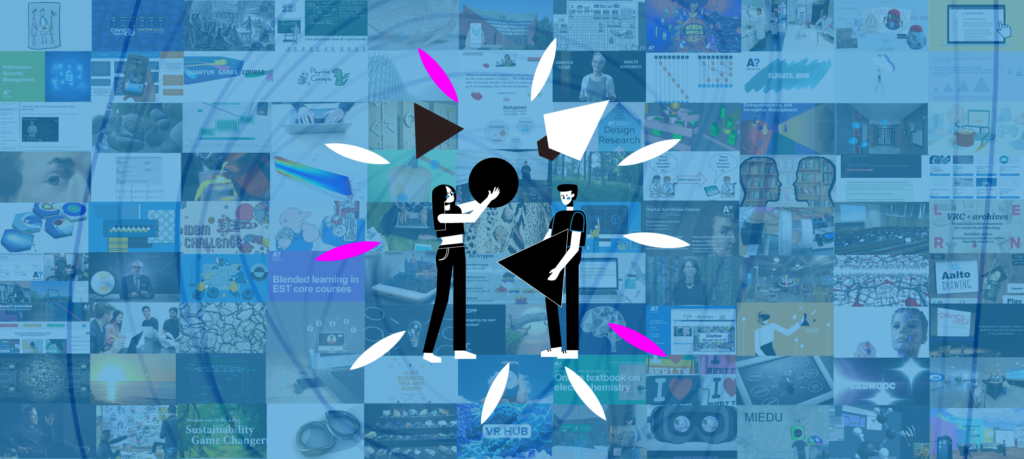Author: Tomi Kauppinen
We are soon celebrating five years of Aalto Online Learning and we want to take a moment to reflect on some of the many interesting projects that have been brought to life, and fantastic things that have happened. We’d also like to invite you to think with us about the future of learning during our December 17 event.
In the presence of a challenging year like 2020, learning today needs to be inherently and widely supported by digital means. Remote teaching and instruction, online learning environments, online programs and courses, and a wide range of media (like podcasts, textual materials, videos, animations, educational games, or mixed reality) enable learners to learn new skills and develop new thinking. The world is calling for novelty in regard to online learning designs, media contents, educational games, models on how to train the trainers, and implementing online master and bachelor programs and courses. Now more than ever, it is important to study new digital learning opportunities to work towards transforming universities to meet the needs of learners in our changing world.
At Aalto Online Learning [10, 13, 9], we have contributed to educational development, research, and essentially to the transformation of education by creating digital learning experiences. We have developed, delivered, experimented, and evaluated new digital tools and online materials in a wide set of online learning themes. These cover augmented and virtual reality (like AALTOLAB or Learning Swedish in 360°), online interactive textbooks, automatic assessment, video production [6], games (check playable concepts [12] and other embedded games for education, e.g. for learning to draw), and online social interaction. We have also proposed and iteratively developed novel event and workshop concepts to create communities of practice where educators can jointly develop online and blended learning settings.
One of our pilot projects has developed the Visual Learning Diary that allows learners to express not just their expectations and competence levels about learned topics, but also their feelings about them. We have recently also studied and visually analyzed the recognition of prior learning of English (see [14]). In Aalto Online Learning, the Language center has been an awesome example of how a complete unit can adapt blended and online learning to be in its core of teaching. Please check the recent fantastic educational development of language courses, and how educators have used augmented reality, videos, and online exercises to ensure and improve learning.
Further, we have experimented with how global collaboration can support learning, feelings of responsibility, and team formation in a global product design marathon [16]. While I argue that this [16] is a very good example of how to blend online and on-site learning, there are quite a few other awesome examples of how to create blended learning settings for courses (take a look). With my colleagues in Münster, Germany, we were interested in how people understand information: does it happen better via visual means, or via raw data tables [4]. We also discussed how to contribute to transparency in society. These questions led us to work on increasing information transparency through Web Maps. This meant essentially communicating relevant issues of information visualizations to improve transparency [3], with a comparison between geo visualizations and bare data tables [4]. I also joined a study about learning music online (via searching from structured representations of music by simply playing the piano on a computer keyboard) [7].
Already way before Aalto Online Learning, I started studying the role and promise of information visualization to help understand and learn about connected phenomena in our global world. See for instance my recent essay [8] at “The Objects of the Forest”- online exhibition at the Helsinki Design Week 2020. I have personally always highly valued international collaboration and have organized quite a few workshops with researchers around the world, for instance, on teaching spatial thinking [1, 2]. Further on, open science and particularly Semantic eScience provide great opportunities to learn via digital means about how previous research settings work, and can thus accelerate scientific discoveries. More on this in the recent Editorial: Special Issue on Semantic eScience: Methods, tools and applications [5].
Last but not least, some years ago we created a model to show that the probability of participating in the same conference again, increases in relation to previous regular participation [15]. We call it the associative nature of conference participation [15]. I have also used the result widely in digital learning designs and for arranging online learning sessions, and for creating a community of educators and educational developers via Aalto Online Learning and its events.
A suggestion for today: Please take a cup of your favorite drink, and spend 30 mins just browsing through all the fantastic projects that our educators have done, from early ideas to finished designs, to help and improve learning. A suggestion for tomorrow: Take another cup to warm you up, or take a 30 min walk, and give one of the Cloud Reachers podcast episodes a listen (Season 1 or Season 2).
More generally, what to do now, as of December 2020, and how should the future of learning look like?
While we still face very challenging times—with (only) remote and online happenings and in distance from other people—we also want to and believe that it is important to celebrate the last five years of Aalto Online Learning. Through all our pilot projects in the last years, we have prepared for the current times with tested online course materials, course and program designs, and production models. We now have a strong community of educators helping each other, also in these online-only times. When we started out, Aalto Student Union recognized us with the Learning Contribution Achievement award 2016, and recently our core idea of Designing Digital Higher Education got the EUNIS Dørup E-learning Award 2020. On December 17th, it is time to celebrate *all* the achievements of these five years, and also to get together to brainstorm how the future of learning and educational development should look like at Aalto University and beyond. Sign up today and join us on the 17th!
PS: Big thanks to Sara Gottschalk for her suggestions on this text. They were to the point and greatly improved the blog post. Thanks Sara!
References
[1] Proceedings of the Workshop on Teaching Spatial Thinking from Interdisciplinary Perspectives, co-located with Conference on Spatial Information Theory XII (COSIT 2015), 2016.
[2] Heather Burte, Tomi Kauppinen, and Mary Hegarty. Teaching spatial thinking from interdisciplinary perspectives workshop (introduction). In Proceedings of the Workshop on Teaching Spatial Thinking from Interdisciplinary Perspectives co-located with Conference on Spatial Information Theory XII (COSIT 2015), Santa Fe, New Mexico, USA, 2016.
[3] Auriol Degbelo and Tomi Kauppinen. Increasing information transparency through web maps. In Companion of The Web Conference 2018 on The Web Conference 2018, WWW 2018, pages 899–904, Lyon, France, April 2018. ACM.
[4] Auriol Degbelo, Jonas Wissing, and Tomi Kauppinen. A comparison of geovisualizations and data tables for transparency enablement in the open government data landscape. International Journal of Electronic Government Research (IJEGR), 14, issue 4:39–64, 2018.
[5] Daniel Garijo, Natalia Villanueva-Rosales, and Tomi Kauppinen. Editorial: Special issue on semantic escience: Methods, tools and applications. Semantic Web, 11(5):731–733, August 2020.
[6] Yulia Guseva and Tomi Kauppinen. Learning in the era of online videos: How to improve teachers’ competencies of producing educational videos. In Proceedings of the 4th International Conference on Higher Education Advances (HEAd’18), Valencia, Spain, June 2018.
[7] Jim Jones, Diego Siqueira, Kleber Tertuliano, and Tomi Kauppinen. MusicOWL: The music score ontology. In Proceedings of the IEEE/ACM/WI Conference, Leipzig, Germany, PhD Mentoring Track on the International Conference on Web Intelligence, 2017.
[8] Tomi Kauppinen. Exploring the Amazon Rainforest through information visualizations. In Andrea Bandoni, editor, The OBJECTS OF THE FOREST online exhibition. Virtual Exhibition Objects of the Forest, September 2020.
[9] Tomi Kauppinen, Yulia Guseva, and Sara Gottschalk. Designing Digital Higher Education: Case Aalto Online Learning. European Journal of Higher Education IT (EJHEIT), accepted, in press 2020.
[10] Tomi Kauppinen and Lauri Malmi. Aalto Online Learning – a pathway to reforming education at the Aalto University. In Proceedings of EUNIS 23rd Annual Congress (EUNIS2017) – Shaping the Digital Future of Universities, pages 212–221, Münster, Germany, June 2017.
[11] Ville Kivimäki, Joonas Pesonen, Jani Romanoff, Heikki Remes, and Tomi Kauppinen. Supporting understanding of students learning via visual self-assessment. In Proceedings of EUNIS 2018 – Coming of Age in the Digital World, Paris, France, June 2018. EUNIS.
[12] Annakaisa Kultima, Christina Lassheikki, Solip Park, and Tomi Kauppinen. Designing games as playable concepts: Five design values for tiny embedded educational games. In DiGRA ’20 – Proceedings of the 2020 DiGRA International Conference: Play Everywhere, 2020.
[13] Lauri Malmi, Tomi Kauppinen, Kirsti Keltikangas, and Päivi Kinnunen. Transforming the learning and educational culture at a university. In Proceedings of the 46th SEFI Annual Conference, Copenhagen, Denmark, September 2018.
[14] Diane Pilkinton-Pihko, Jaana Suviniitty, and Tomi Kauppinen. Recognition of prior learning of English: Test or assess? Language Learning in Higher Education, 9(Issue 2), October 2019.
[15] Jelena Smiljanic ́, Arnab Chatterjee, Tomi Kauppinen, and Marija Mitrovic ́ Dankulov. A theoretical model for the associative nature of conference participation. PLoS ONE, 11(2):e0148528, 02 2016.
[16] Tiina Tuulos, Tomi Kauppinen, Lucas Rafael Ivorra Peñafort, and Diana Isabel Riveros Ospina. Around the world in 36 hours – understanding the dynamics of the global product design relay marathon. In Proceedings of 45th SEFI Annual Conference 2017 – Education Excellence For Sustainability, September 2017.

